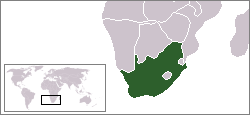Tankwa Karoo National Park
|
Tankwa Karoo National Park
|
|
|
Tankwa Karoo National Park satellite photo |
|
| location | South Africa |
| surface | 1370 km² |
| Geographical location | 32 ° 9 ′ S , 20 ° 2 ′ E |
| Setup date | 1986 |
| administration | South African National Parks |
The Tankwa (Tanqua) Karoo National Park ( English Tankwa Karoo National Park ) is located in the Northern Cape Province in South Africa on the border with the Western Cape Province . The meaning of the word tankwa has not yet been clearly clarified. Attempts at interpretation refer to “cloudy water”, “place of the San” or “thirsty land”. They relate to the character of the landscape.
overview
The national park is located in one of the driest areas of the succulent caroo with 80 mm annual rainfall. However, this small amount is sufficient to cover some parts of the park with a carpet of flowering succulents in spring after the winter rains .
The national park area extends at an altitude of 378 to 1274 m, the average altitude is 450 to 650 m. The higher parts are in the easternmost sector on the Roggeveld Mountains . In the west, the foreland connects to the cedar mountains .
The minimum temperature is 5.7 ° C (July, winter), and the maximum temperature is 38.9 ° C (January, summer).
For more than 1500 years the area has been used sporadically by nomads with their cattle. The European Boers , who moved north from the Cape Peninsula here in the 18th century, used the pastures more intensively. However, the extremely dry summers prevented extensive use, even when boreholes kept supplying water.
The park with its area of 137,000 hectares (ha) was proclaimed in 1986 with a size of only 26,000 hectares, but is still in the development (i.e. conversion of pasture land to its original state) and offers almost no tourist infrastructure.
The art and music festival AfrikaBurn, which lasts several days, takes place annually in April in the Tankwa Karoo National Park .
fauna
The following mammal species can be seen in the park:
African wild cat ( Felis lybica ), scrub hare ( Lepus saxatilis ), Erdferkel ( Orycteropus afer ) Meerkat ( Suricata suricatta ) Erdwolf ( Proteles cristatus ) Fuchsmanguste ( Cynictis penicillata ), common genet ( genetta genetta ), Cape Goldmull ( Chrysochloris asiatica ), Greater Kudu ( Tragelaphus strepsiceros ), African long-eared mouse ( Malacothrix typica ), honey badger ( Mellivora capensis ) Cape Fox ( Vulpes chama ), Cape hare ( Lepus capensis ), caracal ( Caracal caracal ), hyrax ( Procavia capensis ) Cape klipspringer ( oreotragus oreotragus ), crown Ducker ( Sylvicapra grimmia ), leopard ( Panthera pardus ), spoon dog ( Otocyon megalotis ) bears baboon ( Papio cynocephalus ursinus ), jackal ( Canis mesomelas ), Cape Springbock ( Antidorcas marsupialis ), South African porcupine ( Hystrix africaeaustralis ) , steenbok ( Raphicerus campestris ), striped mouse ( Rhabdomys pumilio ) Zorilla ( Ictonyx striatus ).
flora
The following can be observed on succulents in the park:
Aridaria noctiflora , Aridaria splendens , brownanthus ciliatus , Cephalophyllum namaquanum , Cheiridopsis acuminata , codon royenii , Crassula barbata , Crassula deltoidea , Crassula muscosa , Crassula subaphylla , Crassula umbella , Cyrtanthus herrei , Drosanthemum archeri , Drosanthemum eburneum , hispidum Drosanthemum , Drosanthemum liquidate , Drosanthemum subcompressum , Drosanthemum wittenbergense , wittenbergensis Drosanthemum , Euphorbia decussata , Euphorbia hamata , Euphorbia mauritanicum , Euphorbia restituta , Haworthia arachnoid , Hereroa fimbriata , hoodia bainii , Lampranthus diffusus , Leipoldtia constricta , Leipoldtia schultzei , Malephora luteola , Mesembryanthemum pachypus , Othonna arbuscula , Pelargonium crithmifolium , Phyllobolus -Species , Psilocaulon absimile , Psilocaulon pageae , Psilocaulon utile , Ruschia herrei , Ruschia karooica , Ruschia robusta , Ruschia spinosa , Ruschia wittenbergensis , Sarcocaulon crassicaule , Sarcocaulon salmoniflorum , Sceletium ema rcidium , Stapelia species, Tylecodon reticularis , Tylecodon wallichii , Zygophyllum species.
The following can be observed in geophytes :
Albuca cooperi , Androcymbium capense , Bulbine alooides , Cyanella hyacinthoides , Dipcadi brevifolium , gethyllis verticillata , Lachenalia mutabilis , Lachenalia anguinea , Lapeirousia arenicola , Lapeirousia pyramidalis , Moraea speciosa , Ornithogalum apertum , Ornithogalum xanthochlorum .
Web links
- South African National Parks: Tankwa Karoo National Park . National park administration website at www.sanparks.org (English)
Individual evidence
- ^ South African National Parks: Park history . on www.sanparks.org (English)
- ↑ AfrikaBurn

